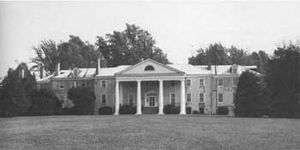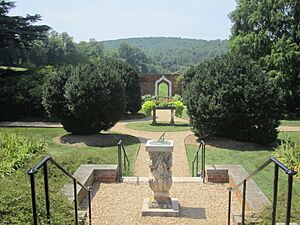Montpelier (Orange, Virginia) facts for kids
|
Montpelier (James Madison House)
|
|
|
U.S. National Historic Landmark District
Contributing Property |
|
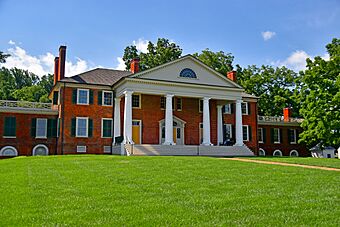 |
|
| Location | Orange County, Virginia |
|---|---|
| Nearest city | Orange, Virginia |
| Area | 2,650 acres (1,070 ha) |
| Built | c. 1764 |
| Website | montpelier.org |
| NRHP reference No. | 66000843 |
Quick facts for kids Significant dates |
|
| Added to NRHP | October 15, 1966 |
| Designated NHLDCP | December 19, 1960 |
Montpelier was the home of James Madison, one of America's Founding Fathers and the fourth president of the United States. He lived here with his wife, Dolley Madison. This historic property is located in Orange County, Virginia.
Today, Montpelier covers about 2,650 acres (1,072 hectares). It is open to visitors seven days a week. It was recognized as a National Historic Landmark in 1966. In 1983, the last private owner, Marion duPont Scott, left the estate to the National Trust for Historic Preservation.
The National Trust has managed Montpelier since 1984. A group called The Montpelier Foundation was created in 2000. Their goal was to make Montpelier a lively place to learn about history. From 2003 to 2008, a big restoration project brought the mansion back to its original size. It now looks like it did when James and Dolley Madison lived there.
Recent discoveries have taught us more about the lives of African Americans who were enslaved at Montpelier. A generous gift helped restore the slave quarters. It also allowed for a special exhibit called The Mere Distinction of Colour to open in 2017. In 2021, the Montpelier Foundation agreed to share leadership with the Montpelier Descendants Committee. This committee is made up of people whose ancestors were enslaved at Montpelier.
Contents
Montpelier's Story
The Madison Family Home
The story of Montpelier began in 1723. James Madison's grandfather, Ambrose Madison, and his brother-in-law received a large piece of land in Virginia. Ambrose, his wife, and their children moved there in 1732. They named their new home Mount Pleasant. Sadly, Ambrose died a few months later. His wife, Frances, then managed the estate with their son, Colonel James Madison Sr..
James Madison Sr. made the plantation bigger in the 1740s. He added services like blacksmithing. He also bought more enslaved people to grow tobacco and other crops. He and his wife, Nelly Conway Madison, had 12 children.
Their first son, also named James, was born in 1751. He spent his early years at Mount Pleasant.
Building the Montpelier Mansion
In the early 1760s, James Madison Sr. built a new house. This house is the main part of Montpelier today. It was built around 1764. It had two stories made of brick. Young James Madison later said he helped move furniture into the new home. This was the first stage of building Montpelier. It became one of the biggest brick homes in Orange County.
The second stage of building started in 1797. This was after James Madison returned home with his new wife, Dolley Madison. They added a large extension and a fancy porch to the house. James's widowed mother, Nelly, still lived there.
The final stage of building happened between 1809 and 1812. Madison added a big drawing room and one-story wings. These new parts gave James and Dolley Madison their own space. After serving two terms as president, James Madison retired to Montpelier in 1817.
James Madison passed away in 1836 and is buried at Montpelier. Dolley Madison moved to Washington, D.C. in 1837. She sold the plantation in 1844. Dolley died in 1849 and was later buried next to James at Montpelier.
After Dolley Madison sold the estate, several other families owned Montpelier. The duPont family bought it in 1901.
Where Did the Name Montpelier Come From?
No one is completely sure how Montpelier got its name. The first time the name was written down was in a letter from James Madison in 1781. Madison liked the French spelling, Montpellier. The city of Montpellier, France, was a famous resort. Letters and visitor descriptions suggest this French city inspired the plantation's name.
Enslaved People at Montpelier
The work at Montpelier was mostly done by about 100 enslaved African people. They worked in many different jobs. Some worked in the fields. Others were domestic servants, cleaning, cooking, and caring for clothes. Some were skilled artisans, working at the mill, forge, or doing carpentry. Many generations of African Americans were born into slavery at Montpelier.
One well-known enslaved person was Paul Jennings (1799-1874). He was Madison's personal assistant from 1817 to 1835. Jennings started working at the White House when he was 10. Senator Daniel Webster bought Jennings from Dolley Madison in 1845 and gave him his freedom. Jennings later became a homeowner in Washington, D.C.
In 1848, Jennings helped plan a large escape attempt. Seventy-seven enslaved people from the Washington, D.C. area tried to sail to a free state. They were captured, and most were sold to the Deep South. Jennings wrote a book about his memories of Madison. It was called A Colored Man's Reminiscences of James Madison (1865). This book is considered the first memoir from someone who worked in the White House.
Researchers have learned a lot about Catherine Taylor (born around 1820). She was born into slavery at Montpelier. Catherine married Ralph Taylor, who was also enslaved. They had four children. When Dolley Madison moved to Washington, D.C., Ralph went with her. Catherine and her children joined him later.
Dolley Madison gave most of the enslaved people to her son, John Payne Todd. He said in his will that they would be freed after his death. But due to legal problems, they were not freed right away. The Taylors asked for their freedom. They were officially freed in 1853. They chose to live in Washington, D.C., where there was a large community of free Black people.
The Montpelier staff continues to study the lives of the enslaved community. They look at old documents and do archaeological digs. They also connect with descendants of those who were enslaved. This helps them understand the contributions and sacrifices of these individuals.
The duPont Family's Time
After some changes in the late 1800s, the duPont family bought Montpelier in 1901. William and Annie Rogers duPont were horse lovers. William built barns and stables for horse riding. The duPonts were important in developing Thoroughbred horse racing in the United States. They also added a "Hodgson House" to the property. These were early prefabricated homes. This house is now called the "Bassett House."
William and Annie had a daughter, Marion duPont Scott, and a son, William du Pont Jr.. Marion inherited Montpelier after her father died in 1928. She kept most of the Madison home and gardens as they were. Marion made only one big change to the house. She updated her parents' music room in the Art Deco style. This room used modern materials like chrome and glass. A weather vane was even installed on the ceiling.
Before Marion's parents moved in, they made the house much larger. They added wings that more than doubled the number of rooms to 55. They also covered the brick exterior with stucco to give it a lighter look.
In 1934, Marion and her brother William started the Montpelier Hunt Races. These horse races use natural hedges as jumps. The races are still held every year on the first Saturday in November.
Marion duPont Scott passed away in 1983. She left Montpelier to the National Trust for Historic Preservation. She also left $10 million to help maintain it. In 1984, Marion's heirs officially transferred Montpelier to the National Trust.
Montpelier Today
Restoring History
Since 1984, the National Trust for Historic Preservation has worked to restore Montpelier. Their goal is to make it look like it did when James Madison lived there. They still honor Marion duPont Scott by keeping one of her favorite rooms in the visitor's center. The annual Montpelier Hunt Races also continue.
In 2000, The Montpelier Foundation began helping to manage the property.
The Robert H. Smith Center for the Constitution provides an Education Center. It helps students and teachers learn about civics. They have programs like "We the People" for students. They also offer seminars for teachers on history and teaching methods.
Montpelier also hosts archaeological digs with James Madison University. From April to November, students and researchers explore the property. They have found many artifacts related to the lives of enslaved African Americans. These discoveries help us understand their daily lives. They show how different parts of the plantation worked together.
From 2003 to 2008, a $25 million restoration project took place. It brought the mansion back to its 1820 appearance. This meant removing the duPont family's additions. The stucco exterior was taken off to show the original brick. The inside of the house was also rebuilt to look like Madison's time. Workers used authentic materials like horsehair plaster. Staff and archaeologists are still working to recreate the rooms as closely as possible.
A special part of the visitor's center is dedicated to the duPont family. It includes a restored Art Deco Red Room. This room was moved from the mansion and is now a permanent exhibit.
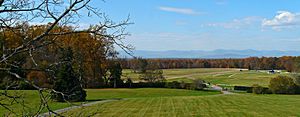
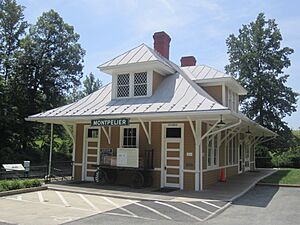
The Mere Distinction of Colour Exhibit
In 2017, Montpelier opened a new exhibit called The Mere Distinction of Colour. This exhibit explores the history of American slavery. It looks at slavery both at Montpelier and across the country. A donation from David Rubenstein helped fund this important exhibit.
The exhibit is located in the cellars of the Madison house. The south cellar tells the story of slavery at Montpelier. The north cellar explains the economics and lasting effects of slavery. This exhibit is the result of many years of research by Montpelier staff and advisors.
A special part of this exhibit is that it was guided by descendants of the enslaved people. These are people whose families lived at Montpelier long ago. Some have family records, and others have oral histories passed down through generations.
The south cellar shares the names of everyone known to be enslaved at Montpelier. It also includes the voices of their descendants. The north cellar talks about how slavery became a part of American society. It also shows how profitable the slave trade was for all the colonies.
Visitors can explore The Mere Distinction of Colour on their own. It is free with any tour ticket and is open Thursday to Monday.
Visiting Montpelier Today
Montpelier welcomes visitors Thursday to Monday. It is closed on Thanksgiving and Christmas. Hours are generally 9:00 a.m. to 4:00 p.m.
There are many activities for visitors. These include a Hands-on-Restoration-Tent and a Hands-on-Archaeology Lab. Kids can also try Kid-Sized Archaeology. Hands-on-Cooking is offered from April to October. Visitors can also explore the Civil War and Gilmore Farm Trail. The Archaeology Dig is open from April to October.
You can also walk over eight miles of trails. These trails go through horse pastures, wildflower meadows, and forests. This includes the 197-acre (80-hectare) old-growth Montpelier Forest.
Fun Annual Events
Montpelier hosts many annual events. Three popular ones are the Montpelier Hunt Races, the Wine Festival, and the Fiber Festival.
The Montpelier Hunt Races are an autumn steeplechase event. Marion duPont Scott and her brother started them in 1934. The races happen on the first Saturday in November. Montpelier has one of the few steeplechase tracks that use traditional hedges for jumps. Guests can watch seven races up close.
The Montpelier Wine Festival features local arts and crafts. It also has specialty food vendors and Virginia wines. About 25 different wineries from the state participate.
The Fall Fiber Festival is held every October. It is a popular event that shows how textiles are made. You can see sheep shearing, craft demonstrations, and other activities. The most popular part of the festival is the Sheep Dog Trials.
Other events include summer programs for children, like "Mud Camp." There's also a summer barbecue with local food. You can join Archaeology Expeditions or see Civil War demonstrations. In December, there's a special candlelight tour of Montpelier in the evening.
Montpelier Forest
A 197-acre (80-hectare) forest on the property is called the Montpelier Forest. It is also known as the Landmark Forest. The National Park Service named it a National Natural Landmark in 1987. This forest is one of the best examples of a mature Piedmont forest. It has many tulip poplar and spicebush trees. Different kinds of oak and hickory trees are also common.
This forest has been mostly untouched. Some trees are up to 300 years old. The rich soil helps the trees grow very large. Tulip poplars can grow up to 120 feet (37 meters) tall by the time they are 50 years old. Some trees have trunks that are 5 feet (1.5 meters) wide.
In Literature
The property is featured in Lydia Sigourney's poem Montpelier. This poem was published in her book Scenes in my Native Land in 1845.
See also
- List of National Historic Landmarks in Virginia
- List of National Natural Landmarks in Virginia
- List of residences of presidents of the United States
- List of burial places of presidents and vice presidents of the United States
- National Register of Historic Places listings in Orange County, Virginia
- Presidential memorials in the United States


